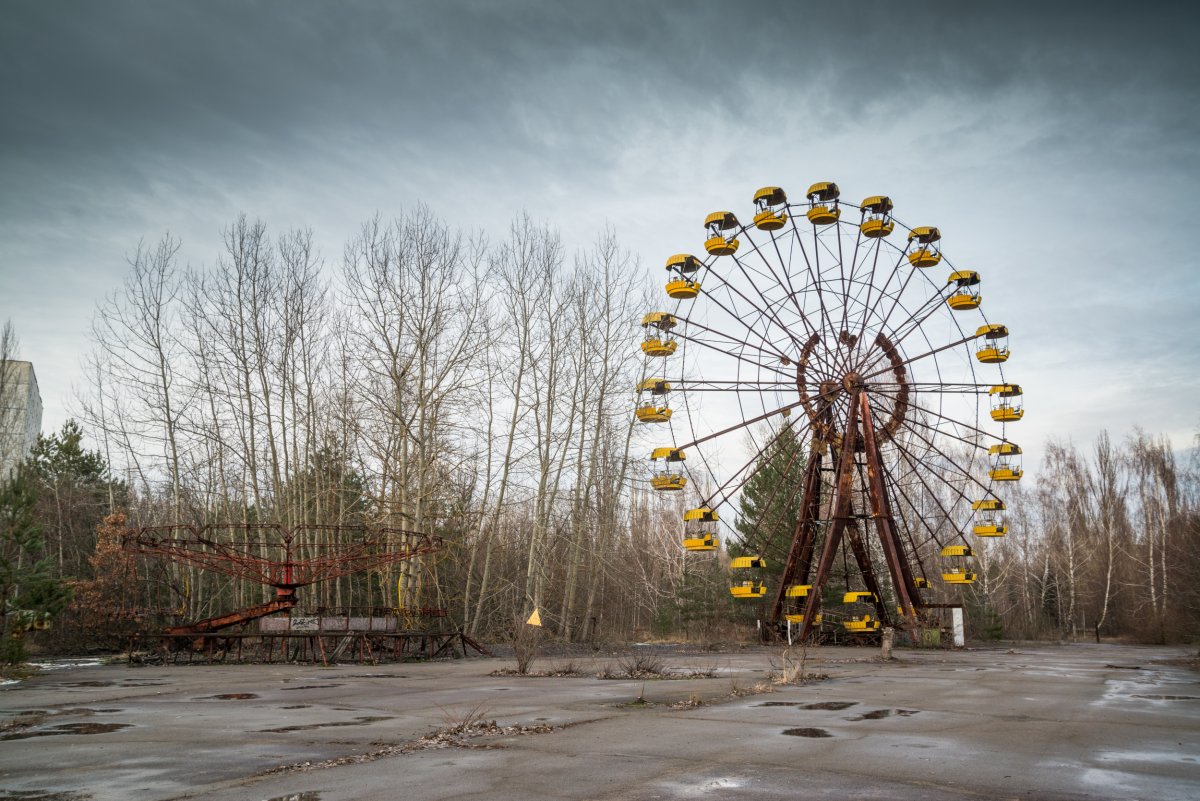The Chernobyl Exclusion Zone in Ukraine remains one of the most radioactive areas of the world.
On April 26, 1986, a meltdown of a reactor in the Chernobyl Nuclear Power Plant caused the world's worst nuclear disaster. The meltdown caused two devastating explosions, which saw radioactive debris and fuel pour out into the surrounding environment. The area is still highly radioactive today.
"It's no exaggeration to say that it contains some of the most polluted territory on Earth," Thom Davies, an associate professor of Geography at the School of Geography at the University Nottingham, told Newsweek. "We'll never know exactly how many people were killed by the 1986 Chornobyl disaster—and estimates range from a few thousand to almost a million. What's certain, however, is that the nuclear legacies of this site continue to this day."
The Chernboyl Exclusion Zone looks like a ghost town today. Buildings are decaying and crumbling as people are not allowed to live there. But that does not mean the land is completely empty.

Despite the radioactivity, it used to be possible for tourists to visit the zone. As many as 100,000 people per year visited the abandoned area. But since February 2022, that has not been possible because of the Russian invasion.
"Before Russia's full-scale invasion of Ukraine, there used to be a thriving tourism industry in Chernobyl," said Davies, a toxic geography expert. "You could buy a day pass and go on a 'toxic tour' of the abandoned site. After Putin invaded Ukraine, however, everything changed."
Where is Chernobyl?
Following the disaster, the Soviet Union isolated the area in the Vyshhorod Raion of northern Kyiv Oblast—a piece of land measuring 1,040 square miles—and declared it to be the exclusion zone, considered the most severely affected area following the disaster. The zone remains in place, although the area is under constant supervision by scientists.
The monitoring was made difficult last February 24, when Russian President Vladimir Putin's troops invaded Ukraine.
"There is a heightened concern of a possible new invasion [via Belarus and Chernobyl] in the air," Tim Mousseau, professor of biological sciences at the University of South Carolina, told Newsweek.
Russian troops occupied the area for a while last February and March. So far, there has not been any long-term effects on radiation distribution detected, Mousseau said.
"But, because of a heightened military presence and increased security in the region, we have not been able to conduct the large-scale surveys that are needed," he said. "Thus, our findings are very preliminary at this stage."
Although it is largely abandoned, the Chernobyl Exclusion Zone has become a haven for wildlife over the years.
"The environment of Chernobyl is a paradox," Davies said. "Despite its reputation as a wasteland, Chernobyl has become a site of high biodiversity. Around 350,000 people were forced to abandon their homes when the exclusion zone was created in the years following the 1986 nuclear accident, and since then nature has slowly begun to recover.
"Today, the zone hosts a growing habitat for populations of elk, wolves and even an endangered species of wild horse, which were almost driven to extinction in 20th century. People I have spent time with during my Ph.D. research around Chernobyl regularly enter the zone to forage for wild berries and mushrooms, despite the risks of radiation."
What caused the Chernobyl disaster?
The Chernobyl disaster began during a routine reactor systems test, when safety measures were ignored. Uranium fuel in the reactor overheated and melted through its protective barriers.
The reactors also lacked a solid containment structure, which is used to seal radiation inside the plant in the event of such an accident. That meant more than 100 radioactive elements entered the surrounding atmosphere.
Do people still live in Chernobyl?
Before the disaster, Chernobyl was home to about 14,000 people. Although humans are not supposed to live there, some survivors remain in nearby villages.
There are no children because they are more susceptible to the effects of radiation, and would most likely suffer long-term effects.
"Parts of it will be [dangerous] for thousands of years, as the radiation slowly decays," Davies said. "However, for people living here a new and more immediate threat has emerged: landmines, abandoned ordinance and unexploded shells.
"Even when the conflict ends and the Russians are finally driven out of Ukraine, the legacy of this war will continue to impact the lives of people here for many decades. For those living around Chornobyl, the remnants of this war will become—like the radiation itself—an invisible but constant presence."
Do you have a tip on a science story that Newsweek should be covering? Do you have a question about Chernobyl? Let us know via science@newsweek.com.
Uncommon Knowledge
Newsweek is committed to challenging conventional wisdom and finding connections in the search for common ground.
Newsweek is committed to challenging conventional wisdom and finding connections in the search for common ground.
About the writer
Robyn White is a Newsweek Nature Reporter based in London, UK. Her focus is reporting on wildlife, science and the ... Read more
To read how Newsweek uses AI as a newsroom tool, Click here.








